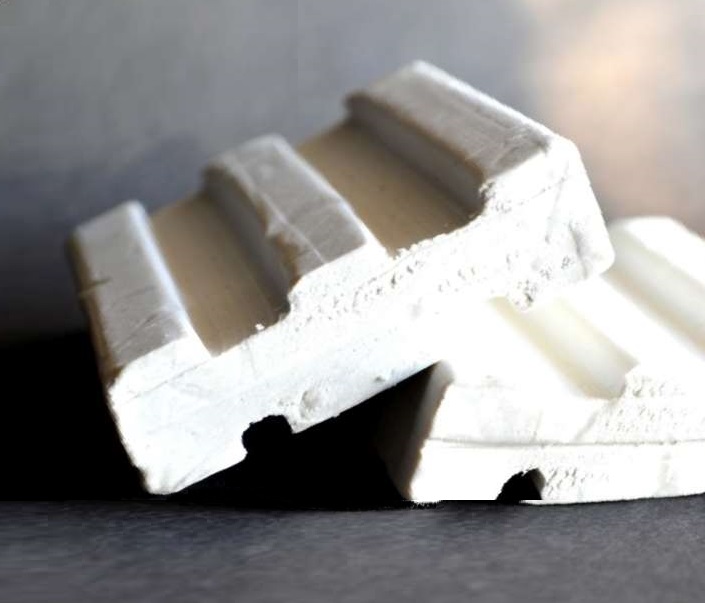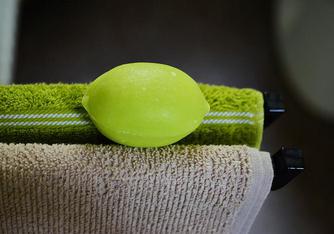Other Indoor Air Quality Contaminants
Mold is the most common of all indoor air quality contaminants. You can learn more about mold from building and non-building sources. Still, there are few unusual indoor air contaminants that may be triggering respiratory irritation, allergic-like reactions or other symptoms. These are considered here. If you are considering having your home checked for mold because of health symptoms, consider these possibilities also.
Allergen Mimicking Enzymes
The exposure route to these enzymes is typically inhalation although its possible for aerosolized substances to affect the eyes at close range to the product. Clinical trials are generally used to establish enzyme-containing products as safe for use by the general public. However, this doesn't preclude reactions in unusual situations such as someone laundering or cleaning much longer than the average person or someone who, because of a past exposure or medical condition, has become exceptionally sensitized or vulnerable to a certain enzyme. Conversely, someone who has had occupational exposures to enzymes such as in baking, food fermentation or detergent manufacturing industries may become more sensitized to mold based on their corresponding enzyme exposures. Enzyme exposure can also occur from unusual occupational circumstances such as biofuel manufacturing or inhaling certain types of animal feed dusts. One study estimated approximately 0.23% of the general population suffers from enzyme sensitivity.
Formaldehyde
This chemical is familiar to most people as the active ingredient of embalming fluid and specimen preservative. So it shouldn't be surprising that it is irritating and toxic. It is a common break-down product, even from our own metabolism! It is used as a solvent in numerous products. It is so common that it is likely to be present in almost all manufactured wood, glue products, hair products and air fresheners. Consumer products made in the United States are often tested and made to comply with the stringent requirements that would enable it to be sold in the California market. However, imported goods are not always vigorously tested. A search of the Consumer Product Safety Commission database of consumer complaints identified a number of different products linked to formaldehyde exposures.
One of the most well-publicized complaints pertained to hardwood laminate flooring manufactured by Lumber Liquidators. However, despite all the media publicity, only twelve official complaints were on record with CPSC between 2012 and 2019 (3 additional complaints did not list the name of the product manufacturer)! This suggests that a majority of the flooring was safe but that lots were occasionally made that were out of specification or shipped too quickly without sufficient curing time for the formaldehyde to dissipate from the product. Installation of large amounts of product in very poorly ventilated areas may have also contributed to the problem.
Anti-Mold and Microbial Coatings
According to CPSC data, another one of the most common complaints is a severe reaction to specialized coatings applied to furniture, including most commonly dimethyl fumerate (DMF). This is more commonly a dermal reaction such as contact dermatitis but other allergic reactions are possible. Is some cases, its unclear whether the coating causing the problem is an anti-microbial or a flame-retardant chemical. Normally, such causes from the exposure becomes self-evident as the person's condition improves when they are away from the object.
Dust Mites/Pet Dander
Dust mites are common microscopic insect-like creatures. They feed on shed human skin cells that accumulate on and within clothing, furniture, carpet, bedding and stuffed toys. The fecal secretions contain a number of allergenic proteins. It is estimated that approximately 10% of the population is allergic to dust mites, including some that may have mild symptoms that are only expressed during severe exposures. Approximately 85% of all asthmatics are allergic to dust mites. Dust mites thrive is warm, humid environments and therefore may less of a problem in the winter. Control measures include frequent cleanings of dust, washing with very hot water, using impermeable barriers on any stuffing material and keeping humidity below 50%. There are also various spray treatments that chemically deactivate the allergens. Testing for dust mite allergen can be done but it is expensive and there aren't well accepted health standards or vigorously tested methodologies. It is typically best to invest in the various control measures. If improvements are seen, it can generally be concluded that dust mite allergen was the source of the problem.
Some people may have sensitized or allergic reactions to certain types of enzymes that are present in some brands of detergents, stain removers, waxes, polishes, essential oils, cat litter and air fresheners. This can include certain "green" products that are using natural enzymes that are biodegradable in lieu of an undesirable chemical. Some detergents may be up to 25% enzymes! Manufacturers are aware of this problem and have tried to reformulate the enzymes to make them more stable and less reactive when inhaled. In addition, these products sometimes contained small amounts of fungal residuals used to make the enzymes. If you are in your 60s or older, you were likely exposed to some of these enzymes before they were reformulated in the 1980s. Even worse, some types of enzymes have been manufactured from genetically engineered organisms (GMO). For GMO enzymes, the safety is more in doubt because formulas are often trade secrets and data trials are closely held information between government and industry that is not readily accessible to independent researchers or watchdog organizations.
Another common source of formaldehyde is foam mattresses, typically those from overseas manufacturers. Ironically, some people have turned to trying foam mattresses due to respiratory problems associated with the accumulation of dust mite allergens associated with conventional mattresses. People sometimes have a worse symptoms with these mattresses. Anecdotally, people have reported hospitalizations or even death from severe reactions to new mattresses. The author's own asthmatic daughter was hospitalized from such a reaction. It may take six months to a year for the chemical off-gassing to subside.
Where formaldehyde is a problem, there are typically other similar volatile organic substances involved such as other aldehydes, vinyl chloride, naphthalene, diisocyanates, and alkenes. In some circumstances, formaldehyde testing may show a product to be safe but the additive or synergistic effects from exposures to multiple similar organic compounds is less well understood. Putting the mattress outside in the hot sun and using a strong fan next to the mattress can help accelerate the release of these chemicals. Indoor volatile organic chemical testing can be performed by means of an indoor cannister test, but it is expensive with the cost starting at $650. Its usually best to use the money for control measures as these substances will eventually dissipate unless there is a continuing source (such as contaminated groundwater below the home).
Dust mites can also live off of the shed skin cells of certain pets. In addition, the shed cells and other secreted substances of certain animals can be allergenic. It is estimated that 2% of the population is allergic to cats. Cat allergen is the most difficult of all animal allergens to control as cat allergens are known to be sticky and more resistant to basic cleaning methods. Certain forms of feline allergen also remain suspended in the air for a longer period of time than ordinary dust particles. Cat allergen sources includes not only the shed skin cells but also the saliva and sweat and anal glands. Children tend to be more sensitive to cat allergen between the ages of 6 and 19 and sometimes grow out of it.
Dog allergies are a little less common, affecting about 1% of the population. The main allergen sources appear to be limited to the skin cells and urine. Dog allergen can also trigger asthma and is not quite as pervasive as cat allergen. Some studies have shown early childhood exposures to dogs reduce the development of allergies to dogs later in life. However, there is some evidence that the reverse is true for cats. This could be evidence of the immunological hazard posed to children from the presence of litter boxes.
Other furry animals can also be allergen sources. This includes rats, mice, rabbits, guinea pigs and other pocket pets. Asthma prevalence is higher among children that have grown up in the inner city and among workers in pet shops due to the exposure to rodent urine, which is the main allergen source of concern for these types of pets. From one study, approximately 20% of children living in inner city housing had asthma triggered by rats or mice.
Bacteria
Excluding incidents involving sewage backups, bacteria are rarely an indoor air quality concern. With the overuse of hand sanitizer and the consumer products industry promotion of germaphobia, bacteria overall have been unfairly maligned. Many forms of bacteria occur naturally and are harmless or even have some beneficial role in competing with less common but more harmful forms of bacteria. One study found that the bacterial slime that formed on an expired water filter actually improved the taste of the water! Another study found that the beneficial bacteria found in yogurt tend to outcompete and thereby suppress the bacteria linked with tooth decay. Thus many bacteria that are neutral or beneficial and are unnecessarily removed by excessive and unnecessary sterilization practices.
The most common airborne bacteria that we are constantly breathing include Gram Positive cocci and rod shaped Bacillus spp. Unlike mold, bacterial exposures during the winter are comparable to the summer. Outdoor concentrations tend to be approximately double the indoor concentrations. When bacteria are elevated in a home, mold is typically going to be a much greater concern. There is no widely accepted method for testing bacteria in air but a sampling method has been developed for bacterial endotoxins, which Tri-Tech offers. This analytical method involves exposing the air sample particulate trapped on an air filter to an extract of red blood cell fluid obtained from horseshoe crabs. The clotting and coagulation of the cellular fluid occurs due to a reaction to certain substances contained in the cell membranes of the bacteria. The measuring of this effect over a known air volume is calculated to a relative index known as “Endotoxin Units,” which is approximately equivalent to 0.1 nanograms (ng) of endotoxin. The resulting air concentration can be compared to normal background levels and the health standards proposed by various authorities. Testing starts at $285 for one air sample.
Surface sampling and microscopic examination can be performed to identify certain types of bacteria. However, we have few health standards for interpretation of the results. Normally, a suspect bacterial hazard source is merely a dirty or soiled surface that can be cleaned and disinfected with care without the need for testing.
The mostly commonly known and pathogenic bacterium is Legionella spp., which thrives in stagnant warm water that has been insufficiently treated with biocide. The exposure occurs when the source is aerosolized. This typically only occurs such as with water fountains and cooling towers and therefore is of minimal risk in the home. Many individuals with functioning immune systems get subclinical infections from environmental exposures of low levels of Legionella.
Cockroaches thrive in urban environments where food and water is plentiful, typically the product of very poor housekeeping or outdoor trash accumulation. Cockroaches will not thrive in homes where food in not left out for long periods of time or spilled and not cleaned up. However, it is possible for cockroaches to travel from an infested apartment to an immaculately kept apartment. In addition, the allergen spreads readily within apartment buildings. An occasional rare cockroach spotted in a home at night might be incidental and of little concern but observing them in the daylight indicates an infestation. Cockroach allergen can be detected in approximately 60% of non-infested homes due to occasional visits or tracked contamination from sources outside the home. It is estimated that about a quarter of the population has at least some sensitization to the allergen.
Exposures are higher in kitchens and bathrooms where they congregate for water. Cockroach allergen does not remain airborne as long as mammalian allergens and is assessed by dust sampling. We do have published background levels and accepted health standards to apply the test results to. A study of asthmatic hospitalizations of inner city residents indicated that cockroach allergen exposure was a major risk factor. Regular cleaning, proper refuse disposal practices and cautious use of household-grade pesticide should be able to eliminate most infestations.
Cockroach Allergens
Hydroperoxide-Based "Green" Cleaning Products
Not to be confused with the familiar and safe chemical hydrogen peroxide, certain classes of chemicals known as hydroperoxides have been used as substitutes to make a product less toxic and more environmentally sustainable. This includes the chemicals limonene, citronellol, linalool, eugenol, and coumarin. These so-called green chemicals have been added to certain cleaners, degreasers, disinfectants, fabric softeners, soaps and air fresheners. This even includes some products marketed to deactivate allergens, such as Pledge Furniture Dust & Allergen Spray!
Unfortunately, some individuals develop allergic responses to these substances. Often the hazards of these products become evident to the user upon exposure. However, an individual who does not clean with these products but lives in the same space where these products are used could experience ill effects and not know the source.
The lesson learned is that more environmentally-friendly and sustainable products are not necessarily safer to certain individuals. Traditional and basic cleaning products such as bleach, ammonia, white vinegar, hydrogen peroxide and basic soap (without additives) work very well (when used as directed) but are inexpensive and not very "sexy" to market. Manufacturer's will always be seeking to design different chemical additives to try to offer more novel cleaning mechanisms and justify the additional cost and markup.




